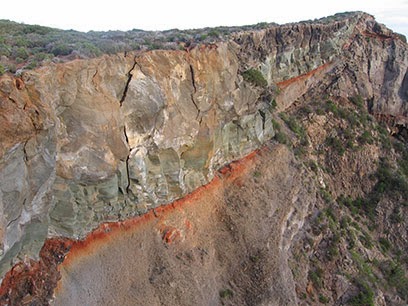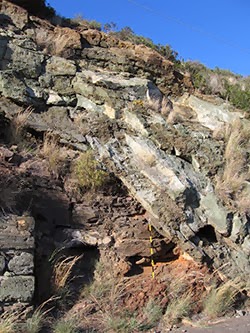
For the first time scientists have tracked how one of the deadliest volcanic hazards moves over time.Pyroclastic density currents are searing hot clouds of ash and gas released by volcanoes; they travel up to 450 miles per hour. Their speed and intense heat make it nearly impossible for humans to observe – anybody who got close enough to monitor one would be killed.
But scientists from the University of Leicester have developed a novel way of reconstructing how one of these currents flowed. Their technique showed for the first time that instead of flowing radially out from the volcano and covering everything in their path, these currents move initially in one direction, but that this direction then changes.
‘In the magma chamber under a volcano the chemistry of the magma at the top is different to the chemistry at the bottom. During an eruption these chemical zones are erupted at different times, so if something was erupted at the beginning it would show a record matching the chemical zone from the top of the magma chamber,’ explains Dr Rebecca Williams, now of the University of Hull, lead author on the project. ‘We realised that if I could find a chemical zoning in an ignimbrite I could use it as a proxy for time.’
The research, published in the journal Geology, looked at a deposit on the volcanic island of Panetelleria left by one of these pyroclastic density currents during an eruption 45,000 years ago.
‘The Green Tuff on Panetelleria was huge. It was much bigger than the ones that buried Pompeii and Herculaneum,’ says Williams. ‘It was very hot when it was deposited which means it welded and turned into a green volcanic glass that covers the entire island. It hasn’t really been weathered, which means it is incredibly well preserved. It is an incredible exposure.’

The chemical structure of this deposit, called the Green Tuff ignimbrite, varies from the bottom to the top, in a similar way to the variation in a magma chamber.
‘If you just look at a deposit you can’t tell it’s zoned. You can’t see it with the naked eye, although sometimes there may be an increase in the size or amount of some crystals. So I took closely spaced samples vertically through the deposit and did a chemical analysis of them to get the chemical compostion from it.’ Williams says.
The team matched the variation seen in the Green Tuff with the same layers in the magma chamber to assess at what point during the eruption they flowed.
They were surprised to discover that the circular deposits often left by these currents didn’t mean that they flowed out in a circle out from the eruption.
‘These really big currents tend to have circular deposit shapes to them so people often think deposits expand radially, going out in all directions at the same time. We’re actually able to show that didn’t happen, it’s only at the climatic phase of an eruption that it flows in all directions at the same time,’ Williams explains.
‘With the Green Tuff the current gradually went over the landscape, it was going off in one direction first and as it moved it was initially blocked by lots of topography, but as it continued moving it would start to creep around and eventually go over any barriers,’ she continues.
The team also showed for the first time that as the eruption tapered off, the pyroclastic density current couldn’t flow as far, so the leading edge appears to retreat over time.
‘This gives us a much better understanding of how pyroclastic density currents behave so it will be a huge help with hazard mapping. It’s really good to know that we can’t think of these phenomena as one very rapid event,’ concludes Williams.
Note : The above story is based on materials provided by PlanetEarth Online









